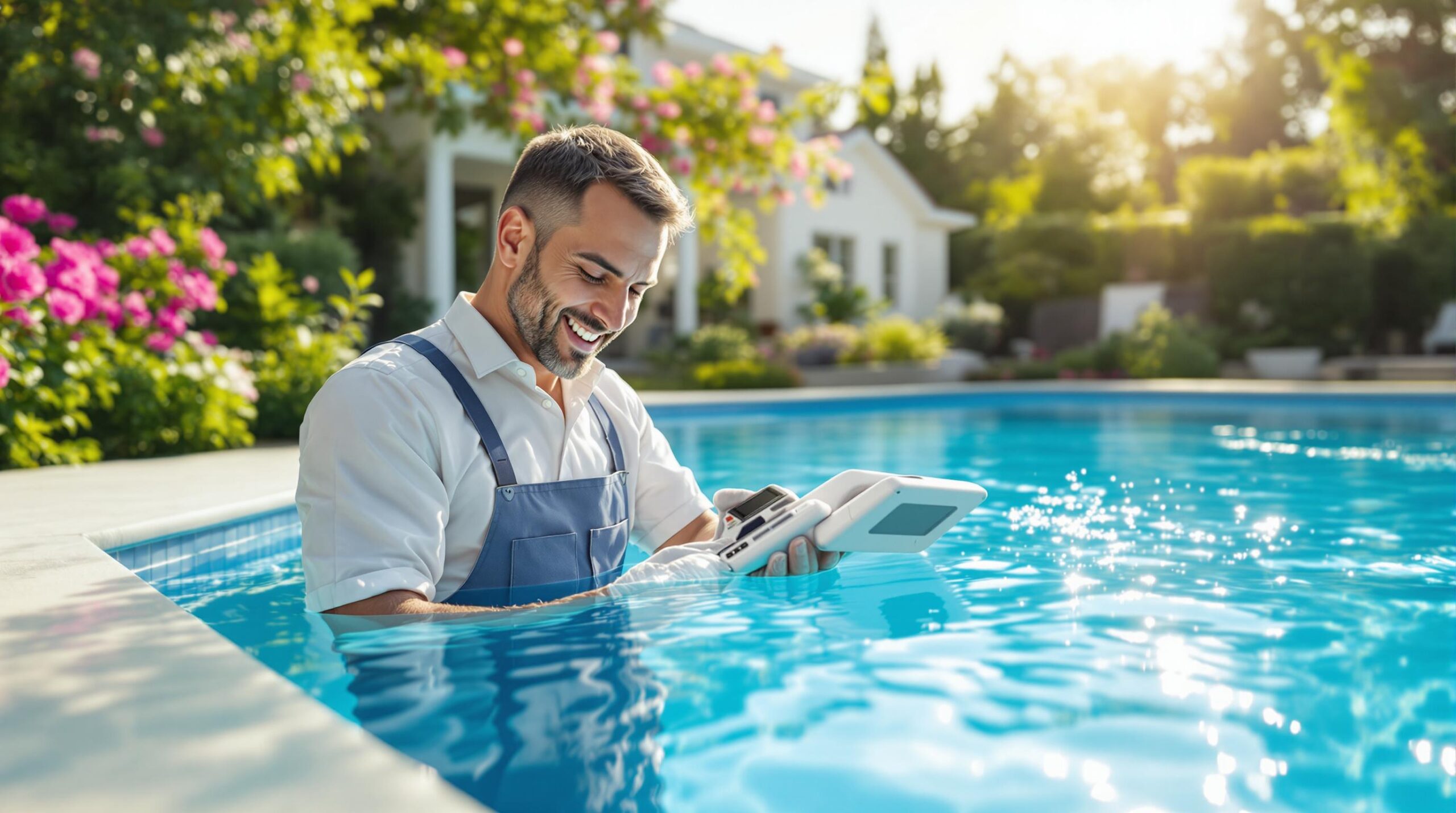Want a clean, safe pool? It all starts with chemistry.
Here’s what you need to know about pool chemicals:
- Sanitizers (Chlorine/Bromine): Kill bacteria and keep water safe.
- pH Adjusters: Balance water acidity to protect swimmers and equipment.
- Algaecides & Clarifiers: Prevent algae growth and keep water clear.
- Testing: Check chemical levels weekly to maintain balance.
Pro Tip: Always store chemicals in a cool, dry place and use gloves when handling them.
Dive into the article for step-by-step guides, safety tips, and solutions to common pool problems like cloudy water or algae growth.
Pool Chemicals for Beginners: How to Test and Balance Water
Functions of Key Pool Chemicals
Every pool chemical has a specific job to keep your pool water clean, clear, and safe for swimming. Here’s how they work together to maintain a healthy swimming environment.
Chlorine: The Main Sanitizer
Chlorine is the go-to chemical for killing harmful bacteria and pathogens in pool water. The ideal chlorine level is between 1-3 parts per million (ppm) [1]. Here’s a quick breakdown of the main types of chlorine and their uses:
| Chlorine Type | Purpose |
|---|---|
| Trichlor | Slow-dissolving tablets for daily upkeep |
| Dichlor | Fast-dissolving for quick sanitizing |
| Calcium Hypochlorite | Used in shock treatments to eliminate chloramines |
Pro Tip: Chloramines, which form when chlorine reacts with contaminants, can cause strong smells and irritation. Shocking the pool helps remove them.
pH Adjusters: Balancing the Water
Keeping the pH level between 7.2 and 7.8 is crucial for swimmer comfort and protecting pool equipment [7]. Two types of chemicals help adjust pH levels:
- pH Increasers: Soda ash (sodium carbonate) raises the pH in acidic water, preventing metal corrosion and surface damage.
- pH Reducers: Muriatic acid or sodium bisulfate lowers high pH, which helps prevent scale buildup and ensures chlorine works effectively.
Algaecides and Clarifiers: Ensuring Clear Water
Chlorine and pH adjusters are essential, but they don’t handle everything. Algaecides and clarifiers tackle specific clarity issues:
- Algaecides: Stop algae from growing and spreading, keeping your pool free of green or slimy patches [8].
- Clarifiers: Gather tiny particles into clumps, making them easier to filter out. This keeps your water sparkling clear.
The APSP recommends using algaecides and clarifiers as part of regular pool care, not just when problems arise [2].
Testing and Adjusting Pool Chemistry
Keeping your pool’s water in balance starts with regular testing and making precise adjustments when needed.
Testing Tools and Frequency
The APSP suggests testing your pool water at least once a week, though during peak swimming season or after heavy rain, you might need to test more often [1]. You have three main options for testing:
- Test strips: Quick and easy for routine checks.
- Liquid kits: Offer more accurate readings.
- Digital testers: Provide professional-level precision.
Steps to Adjust Chemical Levels
Adjusting your pool’s chemical levels requires a methodical approach. Here’s a quick guide to maintaining the key parameters:
Chemical Adjustments Guide:
- Chlorine: Add in small amounts to maintain levels between 1-3 ppm. Wait at least 6 hours between adjustments to avoid overcorrection [8].
- pH: Aim for a range of 7.2-7.8. Use soda ash to raise pH or sodium bisulfate to lower it. For details on specific products, refer to the earlier section on pH adjusters [1].
- Alkalinity: Keep levels between 80-120 ppm. To raise alkalinity by 10 ppm, add 1.5 pounds of sodium bicarbonate per 10,000 gallons of water [4].
Make adjustments gradually to avoid wasting chemicals or causing sudden imbalances.
Important: Always wear gloves and goggles when handling pool chemicals, and never mix different products together [5]. Store your testing tools in a dry, cool place to ensure they stay accurate and last longer.
sbb-itb-5a38398
Solving Common Pool Chemistry Issues
Keeping your pool clean and safe for swimmers means tackling common chemistry problems as soon as they arise. Quick diagnosis and treatment can help you avoid bigger headaches down the line. Below are some of the most frequent issues and how to address them.
Dealing with Cloudy Water
Cloudy pool water usually points to chemical imbalances, poor filtration, or too many contaminants in the water. Start by testing and adjusting key chemical levels like pH, chlorine, and alkalinity. Once balanced, use a pool clarifier to help your filter capture tiny particles.
Key levels to maintain:
- pH: 7.2–7.8
- Free chlorine: 1.0–2.0 ppm
- Total alkalinity: 100–120 ppm
Managing Chloramine Buildup
Chloramines form when chlorine reacts with organic matter like sweat or body oils, leading to strong odors and skin irritation. Here’s how to get rid of them:
- Test for combined chlorine levels in the water.
- Shock the pool using either a non-chlorine shock or a higher dose of chlorine.
- Run the filter continuously to clean the water.
"Using a product like dichlor can rapidly break down chloramines and restore the pool’s sanitizing power" [8].
Handling Green or Algae-Infested Water
Green water often signals an algae problem, and it needs immediate action. Follow these steps for effective treatment:
| Step | Product/Action | Purpose |
|---|---|---|
| Initial Treatment | Algaecide suited to algae type | Kill and remove algae |
| Chemical Balancing | Adjust pH, chlorine, alkalinity | Prevent further algae growth |
| Shock Treatment | Chlorine shock | Oxidize and eliminate dead algae |
| Filtration | Run filter continuously | Clear out dead algae particles |
For tough algae cases, scrub the pool walls and floor daily to stop algae from sticking to surfaces. Make sure your pump and filter are running efficiently to maintain proper water circulation.
Staying on top of regular testing and maintaining the right chemical levels can help you avoid these problems altogether. Prevention is always easier than fixing an issue once it starts [1][7].
Lastly, handling and storing pool chemicals correctly is just as important for keeping your pool safe and enjoyable.
Safety in Handling and Storing Pool Chemicals
Handling and storing pool chemicals correctly is key to preventing accidents and keeping your maintenance routine manageable.
Proper Storage of Chemicals
Set up a dedicated area specifically for pool chemicals. Make sure it’s well-lit so you can easily read labels and instructions.
| Storage Requirement | Details |
|---|---|
| Location | Store in a cool, dry area away from heat, doors, and windows. |
| Container Placement | Use anchored shelves with lips or pallets – never place containers directly on the floor. |
| Organization | Keep chemicals in their original containers and store them separately from one another. |
| Security | Lock the storage area to keep it out of reach of children and pets. |
| Environment | Ensure the space has good ventilation and is safe from flooding. |
Maintain a storage temperature of 50-70°F and inspect containers regularly for leaks or damage to ensure the chemicals remain effective [2].
Safe Handling Practices
Always wear protective gear and follow proper guidelines when handling pool chemicals to minimize risks.
Use gloves, goggles, and a mask, and stick to clean tools for each product. To prepare for potential accidents, keep an emergency response kit on hand. This should include:
- An eye wash station or access to clean water (like saline solution)
- Materials for containing spills, such as absorbent pads or neutralizers
- Emergency contact numbers for quick assistance
Follow the manufacturer’s instructions carefully when measuring and adding chemicals to your pool. Use separate, clean tools for each chemical to avoid cross-contamination [2][3].
Dispose of unused or expired chemicals at hazardous waste facilities to prevent harm to the environment and avoid legal complications [2].
Conclusion: Effective Pool Maintenance with Chemicals
Main Points to Remember
It’s important to test your pool’s water chemistry every week. During periods of heavy use or after significant weather changes, testing more frequently is recommended [1][9].
| Task | Frequency | Details |
|---|---|---|
| Storage Inspection | Monthly | Look for leaks or damage |
| Equipment Cleaning | Bi-weekly | Keep testing tools and gear clean |
The New York State Department of Health highlights that handling pool chemicals properly can prevent many common issues. They recommend using personal protective gear and keeping storage areas organized to ensure safety [2].
If managing pool chemicals feels overwhelming, professional services can take the hassle out of the process.
Simpl‘s Pool Services Overview

Although you can handle pool maintenance yourself, professional services like Simpl’s make it easier and more convenient. Their weekly service program includes:
- Expert water testing and precise chemical adjustments
- Quick, 30-minute service sessions
- Chemical delivery with easy online scheduling
- Updates sent via text or email
Simpl offers two main plans:
Light Maintenance Service starts at $250/month and covers essentials like water testing, wall brushing, and filter upkeep.
Weekly Service costs $365/month and provides more thorough care with professional oversight.
"Regular testing and adjustment of pool chemical levels are crucial for maintaining a safe and healthy swimming environment", say pool maintenance experts [4].
For more details or to book a service, visit Simpl.
FAQs
How often should you add chlorine to your pool?
Chlorine plays a key role in keeping your pool water clean and safe. Typically, you’ll need to add one chlorine tablet every 3-7 days, depending on factors like pool usage, weather, and water conditions [6].
Certain situations may increase the need for chlorine. For example:
- Heavy Pool Usage: More swimmers mean more chlorine is needed.
- Hot Weather: Warm temperatures speed up chlorine consumption.
- Recent Rain: Rainwater can dilute chlorine levels.
- Algae Growth: Extra chlorine is required to address algae.
Regularly test your water using test strips or liquid kits to ensure chlorine levels stay in the proper range. When adding chlorine or any pool chemical, always pour the chemical into water (never the other way around), use clean tools, and store chemicals in their original containers in a cool, dry, and ventilated space [2].
Beyond chlorine, maintaining the right balance of other pool chemicals is just as important. Regularly check these key parameters for a healthy pool:
- pH: 7.2-7.8
- Alkalinity: 100-120 ppm
- Calcium Hardness: 200-500 ppm
For more details on safely handling and storing pool chemicals, refer to the "Safety in Handling and Storing Pool Chemicals" section above [4].






